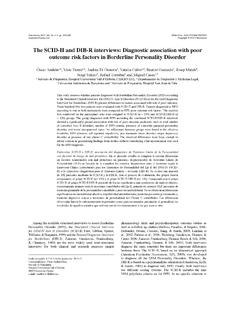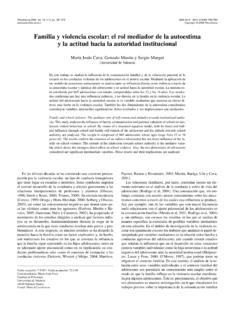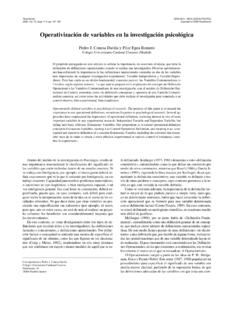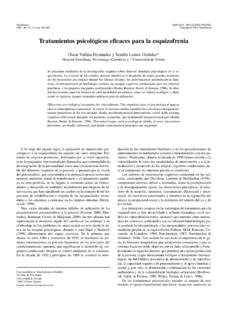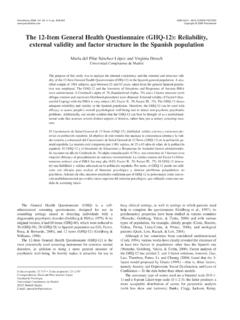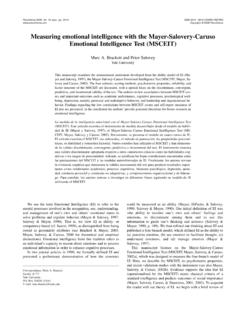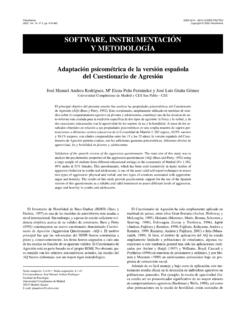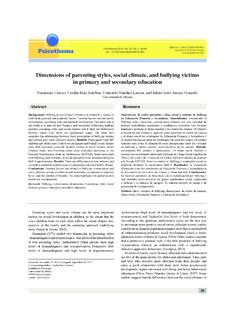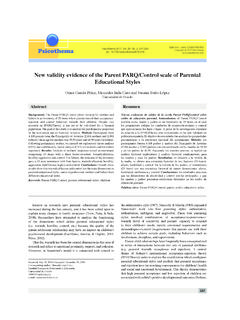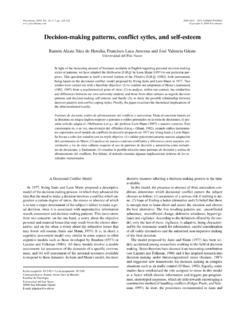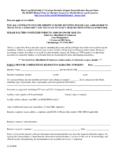Transcription of Psychometric properties of the Brief Symptoms Inventory …
1 One of the fundamental research objectives in clinicalpsychology is to gather empirical evidence on the psychometricproperties of psychological assessment instruments. This evidencecan be used for both patient assessment and evaluating the efficacyof intervention therapies. The present paper analyzes a recentlydeveloped instrument for the assessment of psychological distress:the BSI-18 ( Brief symptom Inventory , Derogatis, 2001). The BSI-18 is the latest, most concise test in an integratedseries of instruments designed by Derogatis to measurepsychological distress. Widely used instruments in the series arethe Brief symptom Inventory (BSI, 53 items; Derogatis, 1993) andthe symptom Checklist-90 Revised (SCL-90-R; 90 items;Derogatis, 1994).
2 Both tests have demonstrated goodpsychometric properties , showing satisfactory indexes of internalconsistency and test-retest reliability, and sensitivity to change(Derogatis, 1993; 1994). However, its weakness is found in thestructural dimension, which has been the object of numerouscriticisms. Although the author of the BSI proposes 9 dimensions,the structure has not been confirmed in the related bibliography:results indicate a unique factor and a number of authors defend theutility of the Inventory exclusively as a general measure of distress(Arag n, Bragado, & Carrasco, 2000: Boulet & Boss, 1991;Piersma, Reaume, & Boes, 1994). The utility of the SCL-90-R and the BSI has been consolidatedas a general distress index in both clinical and research areas(Baider, Peretz, & De Nour, 1993; Geisser, Perna, Kirsch, &Bachman, 1998; Piersma, Reaume, & Boes, 1994.)
3 Strech,Knudson, & Durand, 1998), and these instruments have beenadapted and validated in several languages and samples (Kreutzer, Psychometric properties of the Brief Symptoms Inventory -18 (BSI-18)in a Spanish sample of outpatients with psychiatric disordersYolanda Andreu, Mar a Jos Gald n, Estrella Dura, Maite Ferrando, Sergio Murgui, Amparo Garc aand Elena Ib ezUniversidad de ValenciaThis study analyzes the Psychometric and structural properties of the BSI-18 in a sample of Spanishoutpatients with psychiatric disorders (N= 200), with three basic objectives: (a) to study the structuralvalidity of the instrument; (b) to analyse reliability (internal consistency and test-retest stability) andvalidity (convergent and discriminant) of the instrument, and (c) to evaluate sensitivity to change in atherapeutic context.
4 Using confirmatory factor analysis, two models were tested: the three-dimensionaltheoretical model proposed by its authors, and the empirical four-factor model obtained by the sameauthors through exploratory factor analysis. Our results showed that the best structure was a four-dimensional model, with the General Distress index and Somatization, Depression, General Anxietyand Panic scores. These four scales showed good internal consistency, test-retest reliability, validityand sensitivity to therapeutic change. The BSI-18 has been shown to be a reliable and useful tool forpsychiatric assessment of patients, with the added advantage provided by its simplicity and ease psicom tricas del Brief Symptoms Inventory 18 (BSI-18) en una muestra espa ola de pa-cientes ambulatorios con trastornos psiqui tricos.
5 Este trabajo analiza las propiedades psicom tricasy estructurales del BSI-18 en una muestra espa ola de pacientes ambulatorios con trastornos psiqui -tricos (N= 200) con tres objetivos: (i) estudiar la validez estructural del mismo; (ii) analizar su fiabili-dad (consistencia interna y estabilidad test-retest) y validez (convergente y discriminante); y (iii) eva-luar su sensibilidad al cambio en el contexto terap utico. Utilizando an lisis factorial confirmatorio, sepusieron a prueba dos modelos estructurales: el modelo trifactorial propuesto te ricamente por los au-tores del instrumento, y el modelo emp rico obtenido por los mismos a trav s de un an lisis factorialexploratorio que arroj cuatro factores.
6 Nuestros resultados mostraron que la estructura ptima era unmodelo de cuatro dimensiones que diferencia entre Somatizaci n, Depresi n, Ansiedad general y P -nico. Estas cuatro escalas mostraron ndices adecuados de consistencia interna, fiabilidad test-retest,validez convergente y discriminante, y sensibilidad al cambio terap utico. El BSI-18 ha mostrado serun instrumento fiable y v lido para la evaluaci n de pacientes con trastornos psiqui tricos, con la ven-taja adicional de su simplicidad y brevedad de aplicaci recepci n: 27-9-07 Fecha aceptaci n: 12-2-08 Correspondencia: Maite FerrandoFacultad de Psicolog aUniversidad de Valencia46010 Valencia (Spain)E-mail: 2008. Vol. 20, n 4, pp.
7 844-850 ISSN 0214 - 9915 CODEN 2008 PsicothemaGervasio, & Camplair, 1994; Iwamasa & Kooreman, 1995;Pereda, Forns, & Per , 2007). Recently, Derogatis (2001) haselaborated a new version of this series of instruments: the instrument presents only three scales or dimensions (with sixitems each) of the previous instruments, using the same responsescale: Somatization distress caused by the perception of bodilydysfunction, focusing on Symptoms arising from cardiovascular,gastrointestinal, and other physiological systems that havepowerful autonomic mediation; Depression Symptoms ofdisaffection and dysphoric mood, such as those reflecting self-deprecation, anhedonia, loss of hope, and suicidal ideation.
8 AndAnxiety Symptoms of nervousness, tension, motor restlessness,apprehension and panic states. The selection of these three scalescomplies with two specific fundamental criteria by Derogatis(2001): (i) the verification that about 80% of psychologicaldisorders belong to depressive and anxiety disorders, and (ii) thefact that the presence of elevated Symptoms and somaticmanifestations, which in many occasions provoke depressive andanxiety disorders that are not detected in primary care and aremasked by other somatic BSI-18 also offers a measure of general distress (totalscore), highly correlated with the one offered by the BSI (r>.90),enabling the comparison of the results reached by bothinstruments.
9 According to its authors, this new Inventory presentssatisfactory reliability indexes, both for the dimensions (rangingfrom .74 to .84) and the general distress index (.89) (Derogatis,2001). The authors perform a factor analysis (a principalcomponents analysis with a Kaiser varimax rotation) to examinethe structural validity of the instrument. Factor analysis (in a non-clinical sample of 1134 subjects) yields a four-factor solution. Twoof these factors (I and II) contain the exact items belonging to theSomatization and Depression scales. The other two factors arecomposed of the items belonging to the Anxiety scale originallyproposed: a set of three items related to distress and generalizednervousness integrate Factor III, and three items that assessedpanic Symptoms comprise Factor IV.
10 Nevertheless, the authorsconfirm the structural validity of the instrument because it can stillbe considered a single anxiety dimension (Derogatis, 2001). Thereare two reasons for this: the theoretical relationship between panicsymptoms (Factor IV, Panic) and other common manifestations ofanxiety (Factor III, General Anxiety), and the strong correlationobtained between these two BSI-18 constitutes a new and promising tool for distressassessment in clinical samples and, therefore, requires studies ofadaptation certifying the reliability and validity of the measure indifferent samples and cultures. Thus, we conducted a study of thepsychometric and structural properties of the instrument in asample of Spanish clinical outpatients maintaining threefundamental objectives: (i) a study of the structural validity of theBSI-18; (ii) reliability analysis (internal consistency and test-reteststability) and the validity (convergent and discriminant) of theinstrument, and (iii) an evaluation of the sensitivity to change in atherapeutic context.
